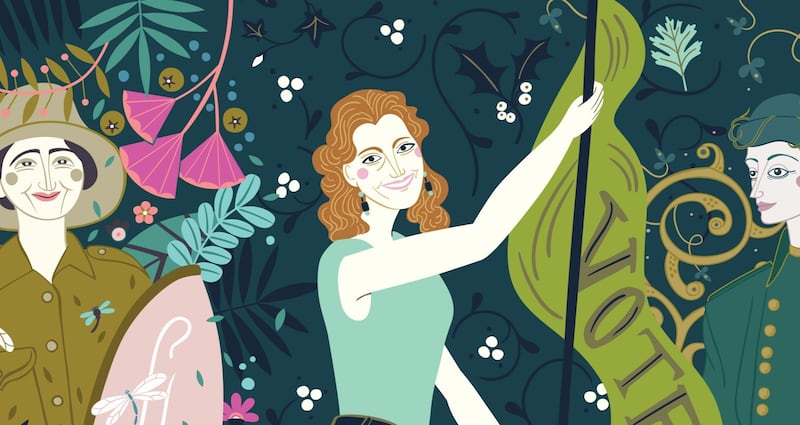Jennie Wyse Power (1858-1941) nationalist and suffragist, was born Jane O’Toole in May 1858 in Baltinglass, Co Wicklow. She was the youngest among four sons and three daughters of Edward O’Toole (died 1876), shopkeeper and small farmer, and Mary O’Toole (nee Norton; died 1877). The O’Tooles were strongly nationalist and she joined the Ladies’ Land League in 1881, becoming a league organiser in Wicklow and Carlow and acting as librarian to Land League prisoners.
As a member of the executive of the Ladies' Land League she became friendly with Anna Parnell and a strong supporter of her brother Charles Stewart Parnell, and remained loyal to Parnell despite his disbanding of the Ladies' League in 1882. On July 5th, 1883, she married fellow Parnellite and journalist John Wyse Power, and moved first to Naas, Co Kildare, and then to Dublin in 1885. The Wyse Powers had four children: Catherine (born 1885), who died in infancy; Maura, called "Máire" (born 1887); Anne, called "Nancy" (born 1889); and Charles (born 1892), named in honour of Parnell. She continued to support Parnell during the split, edited his speeches in the posthumous 1892 collection, Words of the Dead Chief, and served as treasurer to the committee that tended his grave.
She joined the committee founded to support Hanna Sheehy Skeffington; she also took Skeffington daily meals while in Mountjoy prison

Jennie opened a shop and restaurant in 1899 at 21 Henry Street in Dublin called the Irish Farm and Produce Company. This became a popular meeting place for many of the cultural and political organisations with which she was involved. She joined Conradh na Gaeilge, becoming a member of its executive in November 1900. The family holidayed regularly in the Gaeltacht at Ring, Co Waterford, where she was a member of the board of management of the Irish college.
She was a member of the Dublin Women’s Suffrage Association and represented the National Women’s Committee at the Franco-Irish celebrations in Paris in 1900. In the same year, she was a cofounder and vice-president of Inghinidhe na hÉireann (Daughters of Ireland) and a member of the committee that organised the Patriotic Children’s Treat as a counter-attraction to the visit of Queen Victoria. She was elected a member of the board of guardians of North Dublin Poor Law Union from 1903 to 1912, representing the National Council of Arthur Griffith and, from 1908, Sinn Féin.
She was a constant on the executive of Sinn Féin, serving as a joint or sole treasurer at various times and becoming vice-president in 1911. The following year, she was disappointed when Griffith voiced support for the Irish Parliamentary Party’s decision to vote against the Conciliation Bill, which would have extended a limited franchise to women. In the same year she joined the committee founded to support Hanna Sheehy Skeffington, who had been sacked and jailed because of suffragette activities; she also took Skeffington daily meals while in Mountjoy prison.
Jennie was a founder member of Cumann na mBan in 1914 and its first president in 1915, a member of Cumann na dTeachtaire (a women’s group within Sinn Féin) and the Irish Women’s Franchise League. Her business had expanded to four shops, but Henry Street was still the headquarters, and it was here that the Proclamation of the Republic was signed in 1916. Jennie and her daughter Nancy also carried food from the restaurant to the rebels in the GPO as late as Wednesday in Easter week.
She served as an independent senator, being particularly vociferous on matters relating to the status of women
After the Rising she was involved in the Republican Prisoners’ Dependents’ Fund and again became treasurer of Sinn Féin after the “German plot” arrests of May 1918. In 1920 she was elected to Dublin Corporation and took her seat after a row with the council clerk, who initially refused to accept her signature in Irish. She was chairman of the finance and public health committee of the corporation and a governor of St Brendan’s Psychiatric Hospital at Grangegorman in Dublin. She was the only leading member of Cumann na mBan to support the Anglo-Irish Treaty of 1921 and join Cumann na Saoirse. As joint treasurer of Sinn Féin with Éamonn Duggan, she froze the party’s accounts, refusing republicans access to the money. She was appointed to the executive of Cumann na nGaedheal and nominated to the first Seanad in 1922. When Dublin Corporation was dissolved for refusing to strike a rate, she was one of the commissioners appointed to run the city from 1924 to 1929.
By 1925, however, she had become disillusioned with Cumann na nGaedheal and resigned from the party in dissatisfaction with social and economic policy and the result of the boundary commission. She continued to serve as an independent senator, being particularly vociferous on matters relating to the status of women. She spoke against the Civil Service Regulation (Amendment) Bill in 1925, the Juries Bill in 1927, and the Conditions of Employment Bill in 1935 because she felt they discriminated against women. At this time she was a member of the Irish Women’s Citizens’ and Local Government Association and represented Fianna Fáil in the Seanad from 1934 until its dissolution in 1936. Having sold her business in 1929 she had a period of complete retirement from 1936 until her death at home at 15 Earlsfort Terrace, Dublin, on January 5th, 1941. She left £5,308 to her son, Charles.
From the Royal Irish Academy Dictionary of Irish Biography, published by Cambridge University Press










